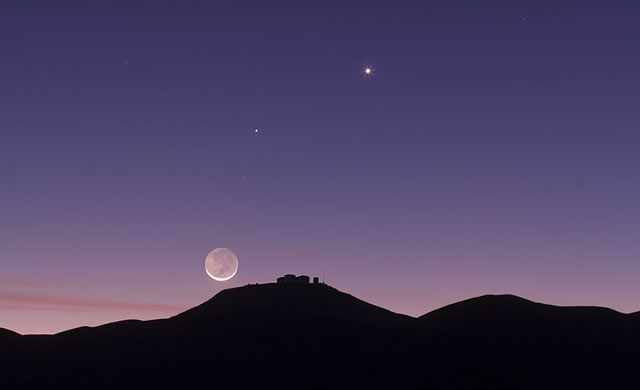
Osservando la Luna con il VLT (Very Large Telescope) dell’ESO, alcuni astronomi hanno trovato prove della presenza della vita nell’Universo, in particolare sulla Terra. Trovare vita sul nostro stesso pianeta sembra un’osservazione scontata, ma l’approccio innovativo di questa equipe internazionale potrebbe condurre in futuro a scoprire la vita anche altrove nell’Universo. Il lavoro è descritto in un articolo che verrà pubblicato nel numero del 1 marzo 2012 della rivista Nature.
“Abbiamo usato un piccolo trucco, cioè le osservazioni della luce cinerea (earthshine, in inglese), per osservare la Terra come se fosse un esopianeta”, dice Michael Sterzik (ESO), primo autore dell’artciolo. “Il Sole illumina la Terra e questa luce viene di conseguenza riflessa verso la superficie della Luna che a sua volta funge da gigantesco specchio e rimanda la luce riflessa dalla Terra verso di noi e questo è quello che abbiamo osservato con il VLT.”
Gli astronomi analizzano la debole luce cinerea per cercare alcuni indicatori, per esempio certe combinazioni di gas nell’atmosfera terreste, che rivelano con certezza la presenza di vita organica. Questo metodo sfrutta la Terra come punto di riferimento per la futura ricerca della vita su pianeti fuori dal Sistema Solare.
Le impronte della vita, quelli che si possono chiamare biomarcatori, sono difficili da trovare con metodi convenzionali, ma questa equipe ha sviluppato una tecnica pioneristica molto più sensibile. Invece che limitarsi a guardare la luminosita della luce riflessa nei vari colori, osservano anche la polarizzazione della luce, una tecnica chiamata spettropolarimetria. Applicando questa tecnica alla luce cinerea osservata con il VLT, i biomarcatori appaiono evidenti nella luce riflessa dalla Terra.
Stefano Bagnulo (Armagh Observatory, Irlanda del Nord, Regno Unito), co-autore dello studio, spiega i vantaggi dela tecnica: “La luce di un esopianeta distante è soffocata dal bagliore della stella madre e perciò è difficilissima da analizzare — un pò come cerare di studiare un granello di polvere vicino ad una lampadina potente. Ma la luce riflessa da un pianeta è polarizzata, mentre la luce della stella madre non lo è. Perciò le tecniche polarimetriche ci aiutano a separare la debole luce riflessa di un esopianeta dalla luce abbagliante della stella”.
Fonte/Comunicato/Leggi tutto: ESO
VLT Rediscovers Life on Earth
By observing the Moon using ESO’s Very Large Telescope, astronomers have found evidence of life in the Universe, on Earth. Finding life on our home planet may sound like a trivial observation, but the novel approach of an international team may lead to future discoveries of life elsewhere in the Universe. The work is described in a paper to appear in the 1 March 2012 issue of the journal Nature.
“We used a trick called earthshine observation to look at the Earth as if it were an exoplanet,” says Michael Sterzik (ESO), lead author of the paper. “The Sun shines on the Earth and this light is reflected back to the surface of the Moon. The lunar surface acts as a giant mirror and reflects the Earth’s light back to us and this is what we have observed with the VLT.”
The astronomers analyse the faint earthshine light to look for indicators, such as certain combinations of gases in the Earth’s atmosphere, that are the telltale signs of organic life. This method establishes the Earth as a benchmark for the future search for life on planets beyond our Solar System.
The fingerprints of life, or biosignatures, are hard to find with conventional methods, but the team has pioneered a new approach that is more sensitive. Rather than just looking at how bright the reflected light is in different colours, they also look at the polarisation of the light [3], an approach called spectropolarimetry. By applying this technique to earthshine observed with the VLT, the biosignatures in the reflected light from Earth show up very strongly.
Co-author of the study Stefano Bagnulo (Armagh Observatory, Northern Ireland, United Kingdom) explains the advantages: “The light from a distant exoplanet is overwhelmed by the glare of the host star, so it’s very difficult to analyse a bit like trying to study a grain of dust beside a powerful light bulb. But the light reflected by a planet is polarised, while the light from the host star is not. So polarimetric techniques help us to pick out the faint reflected light of an exoplanet from the dazzling starlight.”
Source/Continue reading → ESO





















